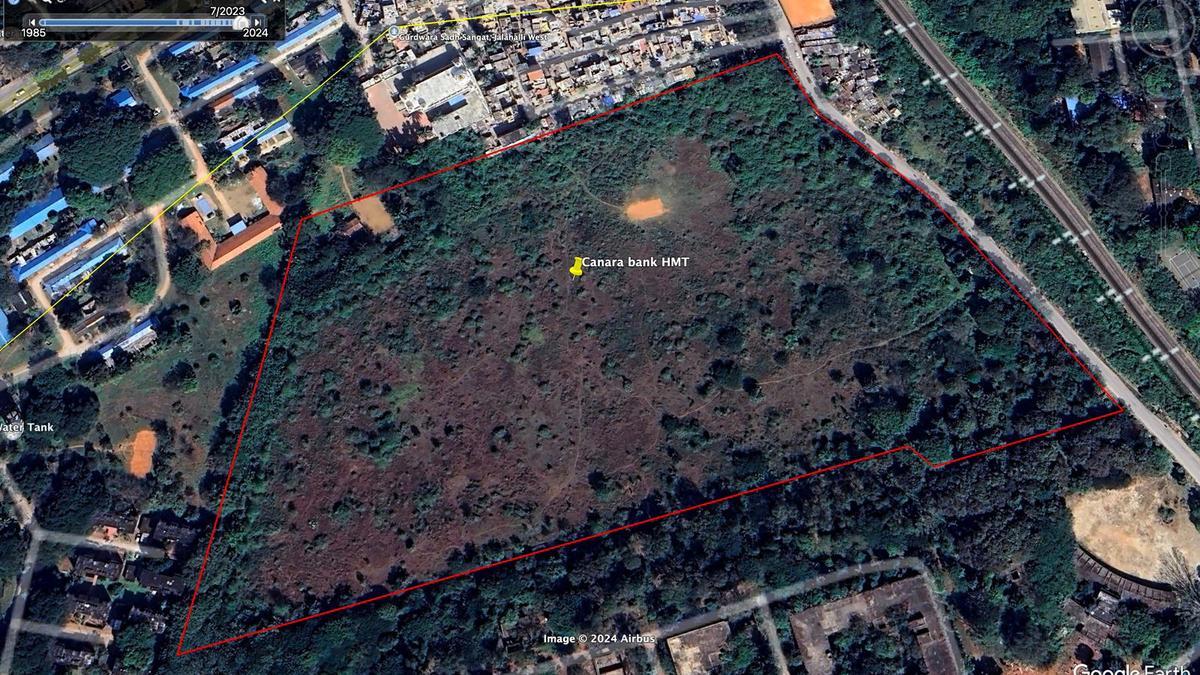
In a dramatic development rocking the Kannada film industry, Environment Minister Eshwar Khandre has leveled serious accusations concerning the illegal cutting down of hundreds of trees on forestland associated with Hindustan Machine Tools (HMT) premises in Peenya. This controversy centers around the Yash-starrer film “Toxic,” with claims that the lush forestland has been cleared partly to make way for expansive film sets. A satellite image of the area reflects the widespread environmental impact, capturing the stark transformation after film sets were constructed.
On Tuesday, Mr. Khandre visited the contentious site and instructed Forest officials to swiftly pursue legal action against those responsible for the allegedly illegal felling of trees. Speaking about the incident, he highlighted that the unauthorized cutting of trees for the movie on forestland governed by HMT has been clearly corroborated by satellite imagery. This revelation comes amid an ongoing clash with Union Minister for Heavy Industries and Steel, H. D. Kumaraswamy, who has accused the State government of retaliatory politics following his announcement to rejuvenate HMT. Mr. Kumaraswamy argues against Mr. Khandre’s plans, viewing them as steps towards reclaiming forestlands that were allegedly “illegally transferred” to HMT during the 1960s.
Minister Khandre has further communicated his concerns by alleging that HMT has been involved in the unauthorized sale of this forestland to various government bodies, private entities, and individuals, prompting diverse non-forestry activities on the premises. Citing evidence, he mentioned, “It has been observed that HMT is renting out portions of the forestland under its jurisdiction for purposes such as film shooting and leasing of open spaces. Recently, on this forestland, reportedly transferred to Canara Bank by HMT, a formidable film set has been established for ‘Toxic,’ and shooting has continued over several months. The clearing involved cutting down hundreds of trees and plants, which constitutes a legal offense.
.”
The minister has called for an urgent assessment to determine if any permissions were granted in accordance with existing regulations. “If permission was extended by any official to enable tree felling on forest land without following the due process, strict disciplinary actions should be applied against involved parties,” Mr. Khandre emphasized. “Should any lapse or absence of permission be discovered, comprehensive action should be taken against everyone accountable for this illegal deforestation,” he added, underscoring the legal implications awaiting the offenders.
In response to these allegations, Supreeth, the executive producer of KVN Productions—the studio behind “Toxic”—has provided a defense, asserting the property’s private ownership and compliance with all relevant regulations. “This is private property, and we have adhered to all possible procedural mandates. We thoroughly scanned this property in February 2024 and handled necessary documentation accordingly. I’m seeking clarification with a complete report from the Forest Department to counter these claims,” Supreeth shared.
As the situation unfolds, it has amassed considerable public interest, compelling concerned parties to await further disclosures or action from the government. Both environmentalists and industry insiders eagerly anticipate the outcome, given the broader implications for environmental conservation and property rights. The robust debate illustrates a vivid clash between development, environmental stewardship, and the artistic demands of film production.
The incident also casts a spotlight on certain systemic challenges, particularly the regulation of land use and ownership rights, raising poignant questions about the historical transfer of lands traditionally marked as forests, and their current applications. It highlights the complexity that arises when conservation goals intersect with economic activities and artistic enterprises—a delicate balancing act that demands careful governance and public accountability.
As the investigation takes its course, many stakeholders are keenly watching for resolutions that reinforce legal compliance while promoting sustainable practices, emphasizing that progress need not come at the cost of invaluable natural resources. The outcome of this high-profile clash can potentially reshape future policies on environmental oversight and resource preservation, providing critical lessons for all parties involved in this tumultuous saga.












